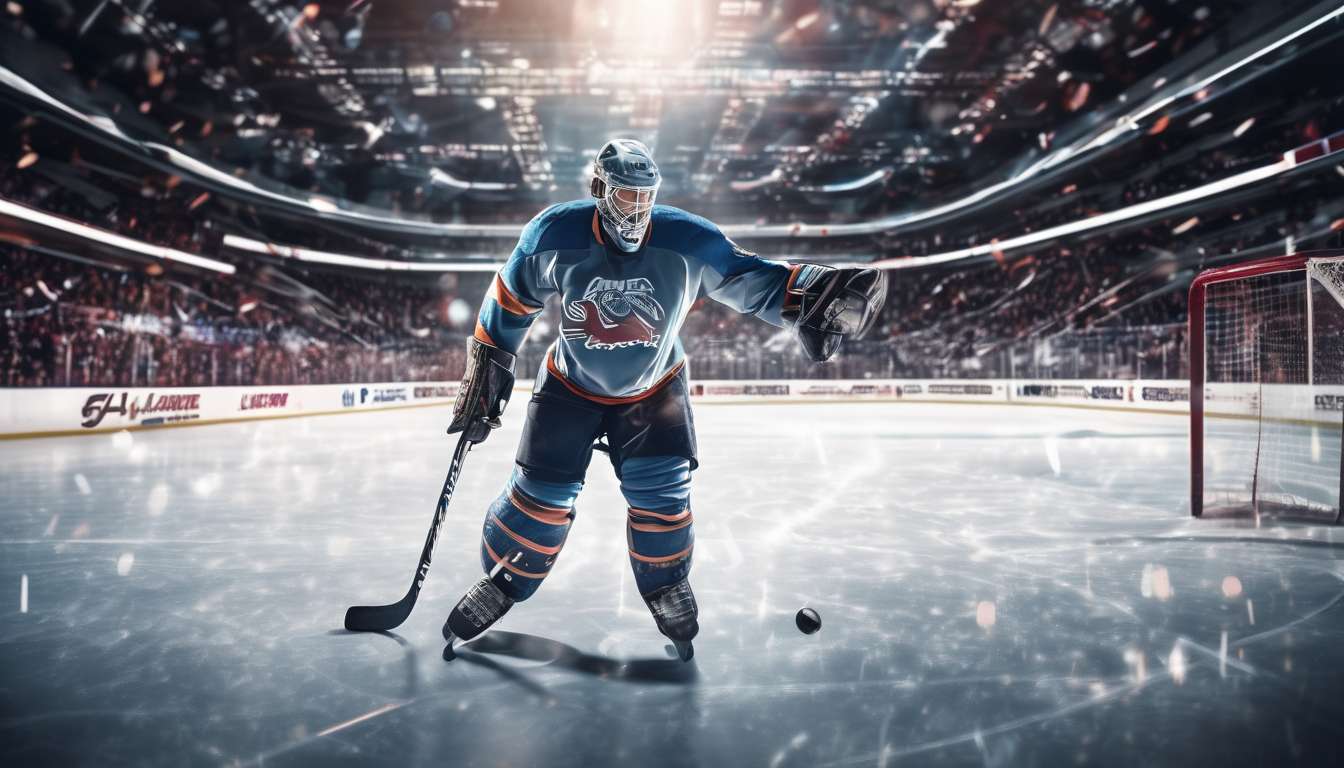As avid hockey enthusiasts, we often find ourselves marveling at the incredible skills and reflexes displayed by goalies on the ice. Their ability to anticipate shots, make split-second decisions, and execute jaw-dropping saves never ceases to impress us.
But how do the experts break down and analyze goalie performance with such precision? In this article, we embark on a journey to uncover the intricate methods and tools employed by professionals to evaluate these guardians of the net.
We will delve into the metrics that go beyond mere save percentages, exploring advanced statistics like:
- Goals Saved Above Average (GSAA)
- High-Danger Save Percentage
The Role of Technology
The role of technology is crucial in providing deeper insights into goalie performance. By utilizing these tools, analysts can capture data that offers a more comprehensive understanding of a goalie’s capabilities.
By understanding the nuances of their performance, we gain a greater appreciation for the mastery that goalies bring to the game.
Join us as we explore the fascinating world of goalie analysis through the eyes of those who make it their mission to understand the art and science behind the crease.
Metrics Beyond Save Percentage
While save percentage is a common metric, we should explore additional statistics that provide a deeper understanding of a goalie’s performance. As a community passionate about hockey, let’s dive into advanced statistics that reveal the nuances of a goalie’s role on the ice. By embracing data-driven insights, we can appreciate the complexities and contributions of our favorite goalies even more.
One advanced metric to consider is high-danger save percentage. This focuses on the saves made in challenging situations where the scoring chances are most potent. This statistic goes beyond the basic save percentage by highlighting a goalie’s ability to perform under the toughest conditions.
Another valuable measure is expected goals against. This uses data-driven insights to predict the number of goals a goalie should allow based on the quality of shots faced.
Together, these metrics shed light on the subtle skills that differentiate an average goalie performance from an exceptional one, bringing us closer to understanding the true artistry of goaltending.
Unpacking Goals Saved Above Average (GSAA)
Goals Saved Above Average (GSAA) is a crucial metric that quantifies a goalie’s performance by comparing the number of goals they’ve allowed to what an average goalie would have permitted in the same scenarios. By focusing on GSAA, we can go beyond traditional statistics and get a clearer picture of a goalie’s true impact.
Key Benefits of GSAA:
- Provides advanced statistics that offer data-driven insights into goalie performance.
- Considers the quality of shots faced, allowing us to gauge a goalie’s effectiveness against league averages.
- Helps differentiate between good goalies and great ones by highlighting their impact in specific scenarios.
By adopting GSAA in our evaluations, we foster a deeper connection with the game and those who play it at the highest level.
The Impact of GSAA:
- Enhances our understanding of goalie performance.
- Enriches our collective hockey experience by providing a nuanced analysis.
- Brings us closer to the heart of hockey performance analysis.
Together, we embrace these insights, knowing they bring us closer to a true appreciation of the game. Let’s continue to explore how these advanced statistics can enrich our understanding and enjoyment of hockey.
Decoding High-Danger Save Percentage
High-Danger Save Percentage (HDSV%) quantifies a goalie’s ability to stop shots from the most challenging scoring areas on the ice.
As hockey enthusiasts, we understand that not all shots are created equal. Shots from high-danger zones pose the greatest threat and require exceptional skill and focus. By examining HDSV%, we gain valuable, data-driven insights into goalie performance, helping us to separate elite goaltenders from the rest.
In our quest for understanding, advanced statistics like HDSV% offer a clearer picture of a goalie’s true impact. They capture moments that basic statistics might overlook, such as:
- How often a goalie stands tall during crucial, game-defining situations.
- The frequency and effectiveness of a goalie’s responses to high-pressure scenarios.
For those of us who appreciate the nuances of the game, these insights foster a deeper connection with the sport.
By embracing these advanced metrics, we not only enrich our understanding of goalie performance but also cultivate a shared appreciation that enhances our community’s love for hockey.
Together, we celebrate the skill and resilience of those guarding the net.
Leveraging Advanced Statistics
In today’s hockey analytics, we rely on a plethora of advanced statistics to gain a comprehensive understanding of a goalie’s true performance. These data-driven insights allow us not only to evaluate the traditional save percentage but also to delve deeper into the more nuanced aspects of the game.
By using metrics such as:
- Expected Goals Against (xGA)
- Goals Saved Above Average (GSAA)
we’re able to paint a clearer picture of a goalie’s contributions beyond just the surface-level stats.
These advanced statistics help us connect as a hockey community, sharing a common language that transcends simple numbers. They enable us to appreciate the intricate details of goalie performance, fostering a deeper appreciation for the skills and strategies that often go unnoticed.
As we parse through these data-driven insights, we can collectively celebrate the elite goaltenders who excel in these metrics and understand the areas where others can improve. Together, we’re forging a path toward a more informed and connected hockey analysis.
Technology’s Impact on Analysis
In recent years, technological advancements have revolutionized how we analyze goalie performance, providing us with unprecedented access to real-time data and sophisticated analytical tools.
We can now delve deeper into the nuances of a goalie’s game, moving beyond traditional stats. Advanced statistics allow us to evaluate every save, shot, and movement with precision, fostering a deeper understanding of what makes a goalie truly exceptional.
By embracing technology, we’ve become part of a community that values data-driven insights, transforming how coaches, analysts, and fans perceive the game. We can pinpoint strengths and areas for improvement, offering targeted support to our goalies.
Our collective knowledge grows as we share insights, making us all feel connected in our pursuit of excellence.
The integration of technology into goalie performance analysis doesn’t just change the way we view the game; it strengthens our bond as we celebrate the intricacies of a position that’s pivotal yet often misunderstood.
Data-Driven Insights into Performance
Through the lens of detailed data analysis, we can identify patterns and trends that reveal a goalie’s strengths and areas for growth. By using advanced statistics, we’re not just spectators; we’re part of a community dedicated to understanding the intricacies of goalie performance. Together, we delve into:
- Save percentages
- Shot locations
- Timing of saves
These factors provide data-driven insights that traditional stats might overlook.
Let’s consider the power of analytics. With data-driven insights, we can measure how a goalie performs in:
- High-pressure situations
- Against specific opponents
Advanced statistics allow us to see beyond the surface, pinpointing where a goalie excels or where they might need support.
Being part of this analytical journey unites us in our passion for the game. We’re not just analyzing numbers; we’re fostering a deeper connection with the sport and the athletes we admire. By embracing these insights, we enhance our collective understanding and appreciation of goalie performance.
Understanding Goalie Capabilities
To truly understand a goalie’s capabilities, we need to explore how their skills adapt and evolve under various game conditions. As we delve into Goalie Performance, it’s crucial to recognize the importance of Advanced Statistics and Data-Driven Insights. These tools help us grasp how goalies handle pressure, adjust to different playing styles, and respond to high-stakes moments. We share a collective appreciation for how goalies demonstrate resilience and adaptability on the ice.
When evaluating a goalie’s performance, we look beyond traditional stats like save percentage or goals-against average. Instead, we focus on metrics that reveal deeper insights, such as:
- Expected goals saved
- Shot quality faced
By doing so, we uncover the nuances in a goalie’s game, allowing us to better understand their true capabilities.
Together, as a community passionate about hockey, we embrace these insights, which not only enhance our appreciation for the game but also strengthen our connection with the players who inspire us.
Appreciating the Art and Science
In our quest to appreciate the art and science of goaltending, we blend tangible data with the intangible instincts that define a goalie’s mastery.
We delve into advanced statistics, which provide data-driven insights that enhance our understanding of goalie performance. These insights allow us to see beyond the surface, revealing patterns and tendencies that might go unnoticed.
Yet, numbers alone don’t capture the full story. There’s an undeniable artistry in how goalies:
- Anticipate plays
- Position themselves strategically
- Make split-second decisions
That artistry is what we connect with on a deeper level. It’s in those moments of sheer brilliance on the ice that we find ourselves in awe, feeling a part of a larger community that appreciates the nuances of the game.
By uniting advanced statistics with our shared passion for the game, we create a space where both the analytical and the emotional aspects of goaltending can coexist, enriching our collective experience and understanding.
How do goalie performances vary across different leagues and levels of play?
Goalie Performances Across Different Leagues
Goalie performances vary depending on the league and level of play. In some leagues, goalies face stronger competition, leading to more challenging performances.
Higher Levels of Play:
- Require goalies to showcase advanced skills.
- Demand quick decision-making.
Differences Between Leagues:
-
Amateur Leagues:
- May have varying skill levels.
- Offer goalies opportunities to develop foundational skills.
-
Professional Levels:
- Present a consistently higher level of competition.
- Require adaptability and advanced techniques.
Conclusion:The diversity and adaptability of goalies across different playing environments highlight the significant differences in performances between amateur and professional levels.
What psychological factors influence a goalie’s performance during high-pressure games?
Psychological Factors in High-Pressure Games
In high-pressure games, psychological factors play a crucial role in a goalie’s performance. The pressure to perform can significantly impact:
- Focus
- Confidence
- Decision-making on the ice
Strategies for Managing Pressure
To navigate these challenging situations effectively, goalies should focus on:
- Mental Toughness: Building resilience to withstand the stress of high-pressure situations.
- Visualization Techniques: Practicing mental imagery to anticipate scenarios and improve performance.
- Staying in the Present Moment: Concentrating on the current play rather than dwelling on past mistakes or future outcomes.
The Importance of Mindset
Our mindset and mental preparedness are key in determining how we perform under pressure. By enhancing our psychological readiness, we can improve our overall performance during critical moments in the game.
How does a goalie’s playing style affect their team’s overall defensive strategy?
Goalie’s Playing Style Impact on Defensive Strategy
A goalie’s playing style significantly influences their team’s defensive approach:
-
Aggressive Goalies:
- Tend to excel at playing outside the box.
- Encourage the team to press higher up the field.
-
Conservative Goalies:
- Prefer staying closer to the goal line.
- Lead the team to maintain a deeper defensive line.
Dynamic Interaction for Success
The interaction between a goalie’s style and the team’s strategy is crucial for success. Understanding and optimizing this relationship helps in building a cohesive and effective defensive unit.
Conclusion
As you delve into analyzing goalie performance, remember to look beyond traditional save percentage. Metrics like GSAA and high-danger save percentage offer deeper insights.
Embrace advanced statistics and technology to uncover valuable data-driven insights. By understanding a goalie’s capabilities and appreciating the blend of art and science in their performance, you’ll gain a comprehensive view of their effectiveness on the ice.
Keep honing your analytical skills to truly understand the nuances of goalie play.

